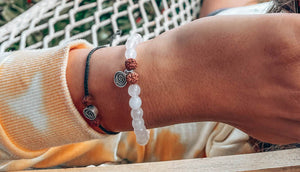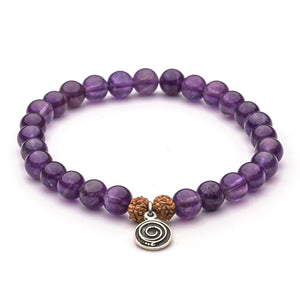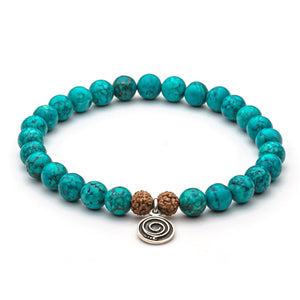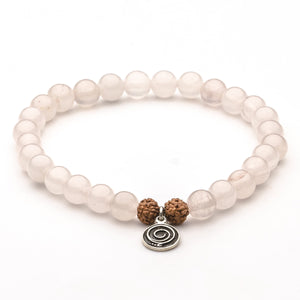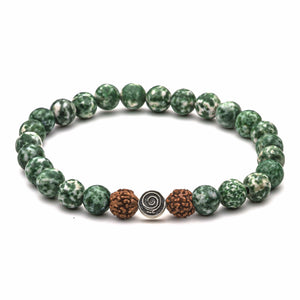THE SYMBOL OF GRATITUDE
Symbols carry so much power. They can evoke memories, emotions, ideas, and meaning and we have used them for thousands of years to get a message or idea across. Symbols are characters or designs to represent something and they often evoke powerful emotion depending on the meaning behind them. They can be recognized internationally across a range of unique cultures, and in using characters instead of words, they are universally understood. Since gratitude is the most powerful emotion, it is only fitting that it has an internationally recognized symbol to carry that power through cultures, communities, and countries alike.
Our brains have the ability to see the design in a symbol and process it in association with a specific word or meaning. When you hear the words “yin and yang” or “fleur-de-lis”, does your brain instantly visualize the symbol behind those words? This is the power of the symbol. As individuals, symbols carry personal power as well. They can be dear to our hearts because of what they signify, and we harness their power through art, tattoos, jewelry, and anything else we see frequently.
Gratitude is an essential part of living a happy and fulfilled life. It helps us appreciate the good things we have, the people who make our life better, and the blessings around us. One way to express gratitude is by using a symbol that represents it.
While until recently there was not an official symbol of gratitude, it is believed the modern-day gratitude symbol is tied to ancient Celtic symbolism. Celtic symbolism frequently used spirals in many of their ancient symbols dating back to 500 BC. The current day universal gratitude symbol uses this as a baseline, representing how gratitude is the center of all things. Here is a picture of the symbol of gratitude so you can see it for yourself!

THE GRATITUDE SYMBOL ELEMENTS
The universal gratitude symbol has two main parts to it: a simple spiral center and three circular dots on the lower exterior of the spiral. It also has a third secondary part on the bottom of the spiral which resembles a hook. This hook is recognized as a Makau, which has a significance in Hawaiian cultures. When dissecting the symbol closely, there is also a subtle lowercase G on the inside of the symbol, subtly representing gratitude.
Part 1: The Spiral Center
The perfect circle is the core of the gratitude symbol with a spiral in the center. A spiral is often used to symbolize many powerful concepts, such as rebirth, the circle of life and evolution, and is often seen as a symbol for change and development. As one of the oldest symbols used in spiritual practices, it also represents accepting the constant changes that life presents to you. These concepts are closely tied to gratitude. Gratitude is, at its core, the act of giving thanks for what you have. Gratitude prompts personal growth which is often seen as personal evolution or even rebirth.
Part 2: The Three Dots
A series of three dots is commonly recognized as an ellipsis, although ellipsis dots do not vary in size like the gratitude symbol. The series of three dots is believed to have a variety of meanings, all of which tie into a gratitude practice. The first thought comes from a grammatical perspective which is that a series of three dots stands for taking further thought or action. This symbolism closely relates to a gratitude practice, as a practice always seeks to find things to be grateful for, and take further action to journal or give thanks.
The secondary meaning of the three dots is a mathematical thought, which represents an infinite list. The beautiful thing about the mathematical representation is that a gratitude list can be truly infinite. There is always something to be grateful for and our list of things to find gratitude in is an infinite number.
Part 3: The Hook (Makau)
The hook at the bottom of the gratitude symbol closely resembles another symbol called Makau, which is an ancient Hawaiian symbol. The Makau is a symbol that represents strength, energy, and abundance. The Makau symbol fits perfectly within the gratitude symbol, as gratitude helps us increase the power of our happiness, giving us emotional strength and energy.

WHAT DOES THE GRATITUDE SYMBOL MEAN?
The gratitude symbol is a powerful representation of gratitude, evoking a sense of appreciation and thankfulness for the good things in our lives. While its meaning may differ from person to person, its purpose remains the same: to remind us of the gifts we possess and encourage us to cultivate a more grateful mindset. By simply gazing upon the symbol of gratitude, we can remind ourselves to pause, reflect and share our gratitude.
Whether you use it as a daily reminder or a gentle nudge towards gratitude. this symbol is a powerful tool to help you stay mindful and thankful.
WHAT COLOR REPRESENTS GRATITUDE?
Understanding the colors that represent gratitude can have a powerful impact on our mind and mood because it brings awareness to it when we see these colors. While several colors are believed to evoke feelings of thankfulness, the most widely recognized color associated with gratitude is the color pink.
Pink is universally associated with love and compassion, and is believed to have mood-regulating properties and can also help reduce aggression. Because of this, it is the perfect color to symbolize gratitude, prompting a sense of positivity and joy.
WHAT GEMSTONE REPRESENTS GRATITUDE?
While there isn't a single gemstone or crystal that is universally recognized as representing gratitude, many stones can be used to symbolize this powerful emotion. From beautiful rose quartz to calming amethyst, there are numerous gemstones that can evoke feelings of positivity and thankfulness. By wearing these stones daily, carrying a crystal, or keeping them somewhere in your home, you can infuse your surroundings with positive energy and a reminder to focus on the blessings of life. Here are some gemstones that have ties to gratitude:
Rose Quartz is one of the stones most associated with gratitude. Pink in color, rose quartz represents the spirit of unconditional love and can help open the heart to giving and receiving feelings of love. This powerful stone will also help release stress, helps with internal healing, and promotes love for yourself and others.
Tree Agate is known for peace and calming. A calm heart can sift through the stresses of everyday life to focus on all they have to be grateful for. This gemstone will serve as a gentle reminder to focus on calming your mind in order to focus on the blessings you have in life.
Amethyst is used for calming. When you are at peace within yourself, you can focus more easily on everything you have to be thankful for. The wearer of this gemstone is encouraged to choose to slow down for a brief moment each day and reflect on everything they have to be grateful for.
The beauty of gratitude is that it can be found in all things. Many crystals and gemstones hold positive meanings, and gratitude can be associated with so many of these emotions! We also use Lava Stone and Turquoise to represent gratitude. While these stones have other meanings, we find they are reflective of the properties of gratitude, too.
HOW DO YOU EXPRESS GRATITUDE?
Gratitude is everywhere we look. It can be a symbol, it can be a practice, it can be the way you think and act, it can be the reason you change the world. We know gratitude has the power to change everything, and it can bring so many other blessings to our lives.
We can express gratitude with our words, with our thoughts, and with our actions, but the most important thing is that we express our gratitude to other people. Take a moment to tell someone you appreciate them and watch their day turnaround. We all deserve to be reminded that we are appreciated and should take time to share this with the people we care about as often as possible.
Read more about the power of gratitude in our Ultimate Guide to Gratitude or experience it for yourself by exploring our daily gratitude journal.

